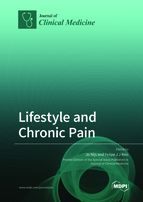Lifestyle and Chronic Pain
A special issue of Journal of Clinical Medicine (ISSN 2077-0383). This special issue belongs to the section "Anesthesiology".
Deadline for manuscript submissions: closed (31 January 2022) | Viewed by 54201
Special Issue Editors
2. Department of Physical Medicine and Physiotherapy, University Hospital Brussels, Brussels, Belgium
3. Institute of Neuroscience and Physiology, Sahlgrenska Academy, University of Gothenburg, Gothenburg, Sweden
Interests: chronic pain; central sensitization; sleep
Special Issues, Collections and Topics in MDPI journals
Interests: pain management; neuropathic pain; pain medicine; pain assessment; chronic pain
Special Issue Information
Dear Colleagues,
Chronic pain has a tremendous personal and socioeconomic impact and remains a challenge for many clinicians. Cumulating evidence shows that lifestyle factors such as physical (in)activity, stress, poor sleep, unhealthy diet, and smoking are associated with chronic pain severity and sustainment across all age categories. A paradigm shift from a tissue- and disease-based approach towards individually tailored multimodal lifestyle interventions should lead to improved outcomes and decrease the psychological and socioeconomic burden of chronic pain. For all these reasons, this Special Issue of the Journal of Clinical Medicine is dedicated to Lifestyle and Chronic Pain. The Special Issue will include five invited state-of-the-art papers, each addressing a key lifestyle factor of importance for patients with persistent pain. These state-of-the-art papers are written by leading experts and key opinion leaders in the field, and will boost the impact and exposure of all papers included in the Special Issue. The present Special Issue offers a unique opportunity to contribute to this breakthrough area of chronic pain, including, but not limited to, the following major areas: musculoskeletal pain, rheumatic pain, paediatric pain, postsurgical pain, cancer pain, pain in athletes, pain in elderly, and neuropathic pain. We welcome submissions from anywhere in the world, as long as the focus of the paper is lifestyle and chronic pain. Manuscript formats can vary from literature reviews (systematic literature reviews and meta-analyses or narrative reviews and perspective articles) to original research (trials, cohort studies, experimental lab work, case-control studies) and consensus statements, as long as they are of high quality and focused on lifestyle and chronic pain. Case reports and study protocols cannot be included. Authors publishing in this Special Issue will contribute significantly to the paradigm shift towards a lifestyle approach for patients with chronic pain!
Prof. Dr. Jo Nijs
Prof. Dr. Felipe J J Reis
Guest Editors
Manuscript Submission Information
Manuscripts should be submitted online at www.mdpi.com by registering and logging in to this website. Once you are registered, click here to go to the submission form. Manuscripts can be submitted until the deadline. All submissions that pass pre-check are peer-reviewed. Accepted papers will be published continuously in the journal (as soon as accepted) and will be listed together on the special issue website. Research articles, review articles as well as short communications are invited. For planned papers, a title and short abstract (about 100 words) can be sent to the Editorial Office for announcement on this website.
Submitted manuscripts should not have been published previously, nor be under consideration for publication elsewhere (except conference proceedings papers). All manuscripts are thoroughly refereed through a single-blind peer-review process. A guide for authors and other relevant information for submission of manuscripts is available on the Instructions for Authors page. Journal of Clinical Medicine is an international peer-reviewed open access semimonthly journal published by MDPI.
Please visit the Instructions for Authors page before submitting a manuscript. The Article Processing Charge (APC) for publication in this open access journal is 2600 CHF (Swiss Francs). Submitted papers should be well formatted and use good English. Authors may use MDPI's English editing service prior to publication or during author revisions.
Keywords
- Chronic pain
- Stress
- Sleep
- Insomnia
- Diet
- Overweight
- Obesity
- Smoking
- Nutrition
- Physical
- activity
- Sedentary
- Exercise
- Pediatric pain
- Cancer pain
- Musculoskeletal pain
- Pain in athletes
- Postsurgical pain
- Rehabilitation medicine
- Psychology
- Physiotherapy
- Occupational therapy
- Rheumatic pain
- Pain in elderly








